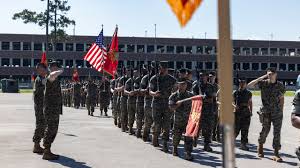Marines in ICE Uniform? The Florida Deployment That’s Raising Eyebrows
In a move that’s caught many off-guard, the U.S. military has deployed 200 Marines to Florida to assist Immigration and Customs Enforcement (ICE). Though officials say their role is purely logistical, critics argue that this blurring of military and civilian lines is rife with risk — and symbolism.
What’s Actually Happening?
Earlier this summer, U.S. Northern Command confirmed that about 200 Marines from Marine Wing Support Squadron 272 (based in North Carolina) would be sent to Florida to provide “administrative and logistical support” for ICE operations.

se Marines, under Title 10 status, are explicitly barred from law enforcement functions. They are not allowed to interact with detainees or engage in the custody chain. Their work will be confined to tasks like data entry, vehicle maintenance, administrative processing, and other support roles.
This initial deployment is part of a broader authorization: up to 700 Department of Defense personnel may support ICE operations in Florida, Texas, and Louisiana.
Why It’s So Controversial
From a policy and optics standpoint, the decision has sparked fierce debate. Here are key tensions emerging:
Blurred Roles & Civil–Military Lines
The traditional separation between military and civilian law enforcement is a fundamental principle in U.S. governance. Even though these Marines aren’t meant to perform arrests, their presence raises hard questions about how far the military can be embedded in domestic policy enforcement.
Perception & Trust
For many communities, seeing uniformed Marines inside ICE operations may deepen distrust — especially in areas with fraught immigration histories. Critics worry this move could be seen as intimidation, even if it’s labeled “non-combat support.”
Operational Risks
In fact, recent reports suggest that some Marine units were called off planned missions because the tasks involved close contact with detainees — something military officials deemed beyond their legal scope.
Stars and Stripes
Instead, National Guard units may fill in for those roles, especially since guard deployments can be more flexible under certain state-federal arrangements.
Legal & Constitutional Questions
Even with restrictions, this kind of deployment bumps up against concerns about the Posse Comitatus Act and the broader risk of militarizing domestic policy. Some veterans and pundits have publicly voiced alarm that shifting military roles into immigration enforcement threatens civilian oversight and public confidence.
Where This Fits in the Bigger Picture
This is not the first time the U.S. military has supported civilian agencies for logistics or infrastructure. What sets the current situation apart is the politically charged nature of immigration and deportation, and the moments when deployments teeter dangerously close to enforcement.
Earlier this year, nearly 700 Marines and National Guard troops were sent to Los Angeles to protect ICE agents during protests — another deployment that reignited questions about domestic military presence.
In many cases, the Pentagon has defended such moves by emphasizing that troops have no authority to detain or arrest — only to cover security and support functions.
Now, the Florida deployment is being held up as a test case: how well can the military walk the line between support and enforcement in such a climate?
Final Take
On paper, this is a logistical support mission — no guns drawn, no arrests made. Yet the symbolism is powerful. A uniformed presence within an immigration enforcement context is always going to stir tension, especially in communities already sensitive to authority and civil rights concerns.
If the government can square the legal, operational, and perceptual risks, this deployment may become a model for how the military aids complex civilian missions.
But if missteps occur, it could be regarded as a dangerous precedent — a slide toward normalizing military involvement in civilian enforcement.
